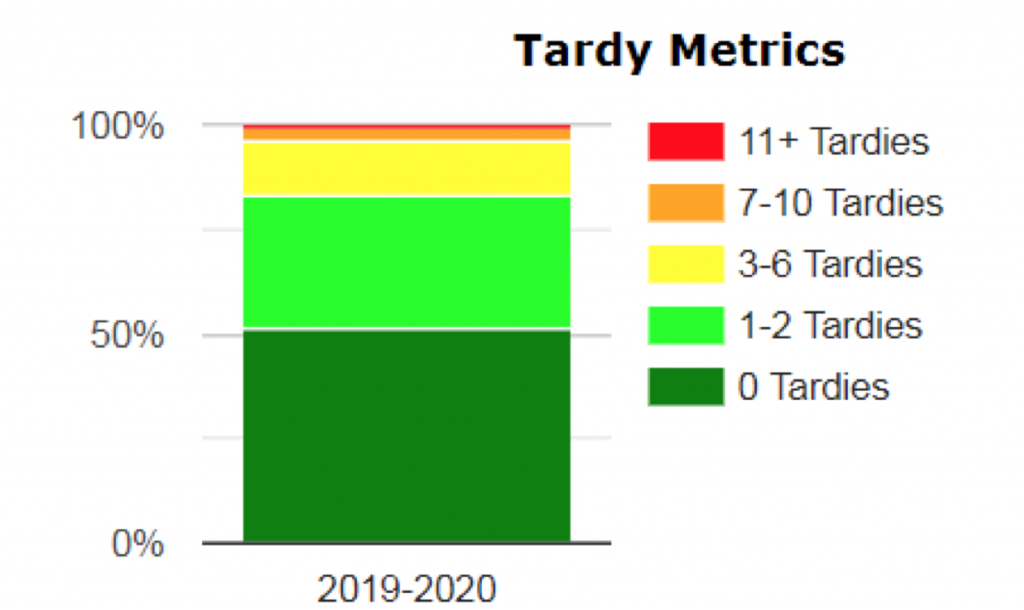By: Annabelle Williamson

During the 2018/2019 school year, only 3.5% of students went tardy-free, which means 96.5% of the student body was tardy last year.
It is almost impossible to predict the tardy outlook for the upcoming year, as it fluctuates each year without a pattern, but by looking at last year, our tardy percentage for 2019-2020 is trending down.
The administration team at Redwood hoped to start off the year right by going into feeder schools before the end of last year. They taught Redwood’s expectations for tardies and absences and what would be done in the case of excess tardies.
As of last year, Redwood’s passing periods were 9 minutes. This year, an extra minute was added to help students get to their classes on time, taking in the fact that overcrowding on the bridge keeps students going from the main campus to Sierra Vista quickly.
Redwood administrators also started this year to push students to class before the ‘2-minute mark’ which many of our upper class-men were used to. They wanted students from Sierra Vista to see an empty campus when they got to main in order for them to go straight to class.
Mr. Marroquin, Redwood Assistant Principal, monitors tardies daily. The administration team can tell whether men or women are tardier, who has the most tardies in the school, and which grade is always late. They can do all of this with absences too.
“65% of our kids have zero tardies…On the opposite, they’re only 7 kids that have over 11+ tardies.”
Assistant Principal, Mr. Marroquin
“We have 3 more days in August and we have 1800 tardies. We’re down about 400 tardies from last year.” Mr. Marroquin talks about the 2018-2019 school year in comparison to this year. “65% of our kids have zero tardies…On the opposite, they’re only 7 kids that have over 11+ tardies.”
The admin team has initiated many new tactics to cut down on the huge increase in tardies they saw last year. “The teachers have done a phenomenal job being at their doorway, meeting kids… our admin team and the campus supervisor have done a better job of encouraging kids to go to class earlier, without a whistle,” Mr. Marroquin says.
Mr. Lor, another Assistant Principal at Redwood, is grateful that the tardies this year have gone down. “Last year there was a jump in tardies but the year before that there was a dip.” Mr. Lor says.
There’s no consistent trend in the increase or decrease of tardies any given year but the administration does believe that there is a certain time of year where it’s more likely for students to be late.
“The longer the stretch, where the kids don’t have a break like thanksgiving break or spring break… there tends to be an increase in tardies…correlates to lack of break time,” Mr. Lor says.


Due to senior attendance policies, senior tardies are consistently low every year. Fear of not being able to walk in graduation because of excessive tardies and absences is a strong motivator for students. To this point in the year, sophomores are tardy the most, followed by juniors, and then freshmen. Mr. Marroquin attributes this dip in freshmen tardies to going to the feeder schools the year prior and teaching Redwood’s expectations and rules before they came.
In contrast to the unpredictable number of tardies each year, the administration sees a certain trend in the kind of students who are regularly tardy and absent. “They struggle academically, and there are different barriers to their successes whether it’s their home lives, social-economic situation, or lack of confidence… usually that’s what sets some students apart,” Mr. Marroquin says.
The administration knows the type of students who are more likely to be late than others. “They don’t have the confidence or the experience to perform in class and they’re reluctant because they don’t have the skills or they’re ashamed of their level,” Mr. Marroquin says.
Tags: visalia

